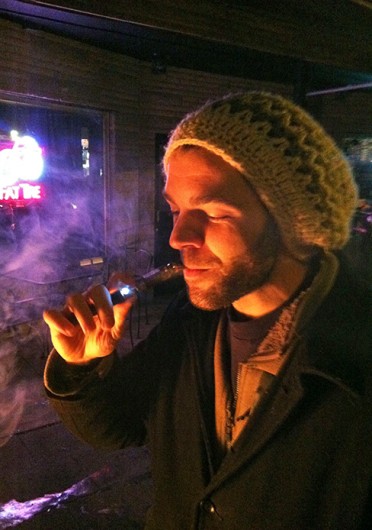
Columbus resident Phil Risko takes a drag from his e-cigarette while listening to local music at the Woodlands Tavern on Jan. 30. Risko said bought an e-cigarette to quit smoking cigarettes.
Credit: Jonathan McAllister / Asst. photo editor
Since Ohio State instituted a campus-wide tobacco ban at the beginning of the year, no one has faced any official punishment from the university for smoking on campus.
As a result, people still smoke on campus, but their numbers might be waning, said Dr. Peter Shields, deputy director of the Wexner Medical Center James Comprehensive Cancer Center.
The university is confident it will achieve long-term results without a specific enforcement policy, he said, and people that get infractions for repeated violations tend to be those that break multiple rules anyway. So far, no one has had serious repercussions for tobacco use on campus, Shields said.
The ban, which forbids cigarettes, tobacco chew, e-cigarettes, snuff and snus from being used on campus, has sent some staff, faculty and students off-campus for their smoke breaks. Others, though, haven’t changed their habits.
Though some students might be under the impression that those breaking the policy could face fines, the punishment isn’t enforced by University Police. OSU Human Resources and the Student Conduct Board handle that instead.
Shields said the message is being pushed out through a combination of educational signage and the informal enforcement of faculty, staff and University Police reminding violators of the ban.
And most of the ban’s $100,000 has gone to signage, Shields said. As of Wednesday, more than $80,000 had been spent on temporary and permanent signs at all OSU campuses, he said.
There is also a $20,000 budget for a supply of nicotine replacement drugs, so that those trying to quit can try out different products. Shields said that funding has been approved but requires more research on aspects such as potential side effects before implementation.
He said the committee that created the ban didn’t even think about a formal enforcement policy.
“It wasn’t even a discussion,“ Shields said. “When it comes up in a meeting, everyone looks at each other and says, ‘Yeah, no, let’s just move on.’”
The Medical Center is the only area on campus with serious enforcement, and its ban started in 2006. Shields said in November those penalties include firing employees after they’re caught smoking twice.
“We’re not gonna be that heavy-handed,” Shields said more recently.
If the university is informed of larger or group issues with the ban being broken, OSU will change the signage and educate people in the area of the policy to help prevent further violations, Shields said.
Last week, a tobacco-free program coordinator, based in the Student Wellness Center, was hired on a part-time basis to directly handle complaints and take the lead on these targeted efforts.
Other schools have created similar bans but enforce them in a different manner, such as Tulane University, which implements $25 fines on those who break the ban, according to its website.
“It’s up to the, for example, the department chairs, to say … to a faculty member that they shouldn’t be smoking on campus. It only takes, you know, one or two times for your chair to tell you that and you’re gonna listen,” Shields said. “People don’t get written up for every little infraction.”
The university will have data this fall to measure the scientific effect of the ban, Shields said.
“Anecdotally, people continuously say to me they feel like it’s so much less than it used to be,” Shields said. “But, as a scientist, I wanna see the data.”
He said, though, it will be tough to come to conclusions about the ban this early in the process.
“The tobacco policy has only really been in effect one full semester,” Shields said. “We just don’t have the data yet.”
Part of the plan for tracking effectiveness is a cigarette butt cleanup, where the university will compare numbers from last year. Shields said this might also prove inconclusive without multiple years of data.
Some students, like Joe Cipollone, a first-year in accounting, said they have not felt the full effect of the ban.
“I’m gonna be honest, I’ve smoked on the campus and I never had anyone tell me to not smoke,” Cipollone said. “I’ve never had anyone actually enforce it.“
Cipollone has made attempts to avoid violating the ban, he said, but it has not stopped him from smoking.
“I’ve tried to smoke off-campus when I can,” Cipollone said. “But if I’m walking to class, you know, (the ban) is not really gonna affect me.”
Shields said he knows there are still students who smoke on campus, but that the long-term goal is more important than punishing violators.
“The primary goal is to change, to change culture and reduce smoking among faculty, staff and students,” Shields said. “It’s more about the message.”


